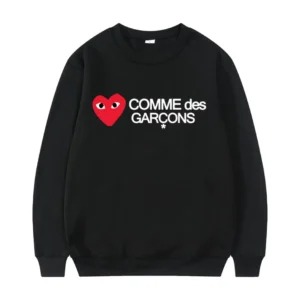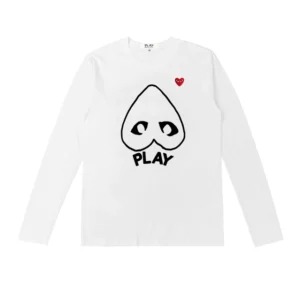
Comme des Garçons (CDG), a revolutionary force in the fashion industry, has consistently pushed the boundaries of design and creativity since its inception. Founded by Rei Kawakubo in 1969, the brand has become synonymous with avant-garde fashion, challenging conventional aesthetics and redefining beauty standards. This article explores the origins, philosophy, iconic designs, and lasting impact of Comme des Garçons.
Origins and Philosophy
Rei Kawakubo, a self-taught designer from Tokyo, established Comme des Garçons to express her unique vision of fashion. The name, translating to “like boys” in French, reflects Kawakubo’s androgynous approach to design, which often blurs the lines between masculine and feminine aesthetics. Her philosophy centers on imperfection, deconstruction, and the beauty of the unconventional, rejecting traditional norms in favor of a more thought-provoking, intellectual style.
Kawakubo’s work is often rooted in a deep philosophical inquiry. She believes that fashion should not only be about creating beautiful clothes but also about challenging societal norms and provoking thought. This approach has led her to create collections that are as much about art and conceptual ideas as they are about wearability. Her designs often explore themes such as identity, gender, and the human condition, offering a unique perspective that resonates with those who seek more than just fashion in their clothing.
Distinctive Aesthetic
Comme des Garçons is renowned for its distinctive, avant-garde aesthetic. Kawakubo’s designs often feature deconstructed silhouettes, asymmetry, and innovative use of materials. Her collections are known for their conceptual depth, exploring themes such as beauty, identity, and societal norms. CDG’s garments are not merely clothing but wearable art pieces that challenge perceptions and provoke thought.
The brand’s aesthetic is characterized by a bold use of black, unconventional shapes, and an emphasis on texture and form over color and print. This minimalist yet complex approach has set CDG apart in the fashion industry, earning it a dedicated following among those who appreciate its intellectual rigor and artistic integrity. Kawakubo’s ability to turn flaws and imperfections into points of beauty has redefined what it means to be fashionable, making CDG a symbol of avant-garde fashion.
Revolutionary Runway Shows
CDG’s runway shows are legendary for their artistic vision and conceptual depth. Kawakubo transforms the runway into a stage for exploring complex themes, often collaborating with artists, musicians, and architects to create immersive experiences. These shows transcend traditional fashion presentations, offering profound commentary on various aspects of the human condition. Each runway presentation is a testament to Kawakubo’s ability to push the boundaries of fashion and art.
One of the most notable aspects of CDG’s runway shows is their ability to provoke and challenge. Kawakubo’s presentations are not just about showcasing clothes but about creating a narrative and eliciting an emotional response. Her shows often feature theatrical elements, from elaborate set designs to thought-provoking music and performance art, making each show a unique and unforgettable experience. This innovative approach to runway presentations has set a new standard in the fashion industry, inspiring other designers to think outside the box and use their shows as a platform for artistic expression.

Cultural Impact and Collaborations
Comme des Garçons‘ influence extends far beyond the runway. The brand has collaborated with numerous artists, designers, and global brands, further solidifying its cultural impact. Partnerships with Nike, Supreme, and the Metropolitan Museum of Art have introduced CDG’s avant-garde sensibilities to new audiences, bridging the gap between high fashion and popular culture. These collaborations showcase CDG’s ability to innovate and remain relevant in a rapidly evolving industry.
One of the most notable collaborations was with Louis Vuitton, where CDG’s unique aesthetic was combined with the luxury brand’s iconic monogram, creating a collection that was both avant-garde and commercially successful. Similarly, CDG’s collaboration with Converse resulted in the iconic Play line, featuring the instantly recognizable heart logo. These collaborations have not only expanded CDG’s reach but also demonstrated its ability to adapt and innovate while maintaining its distinct identity.
Dover Street Market: A Retail Revolution
In 2004, Kawakubo and her partner, Adrian Joffe, launched Dover Street Market, a revolutionary retail concept that challenges traditional retail norms. With locations in major cities worldwide, Dover Street Market offers a curated selection of Comme des Garçons collections alongside other avant-garde designers. Each store is a dynamic space that blurs the lines between fashion, art, and commerce, reflecting Kawakubo’s vision of creating transformative retail experiences.
Dover Street Market is not just a store but an experiential space that embodies CDG’s avant-garde philosophy. The stores feature unique installations, art exhibits, and innovative merchandising that create an immersive shopping experience. This approach has redefined retail, making it a destination for those seeking not just to purchase clothes but to engage with fashion as an art form. Dover Street Market’s success has led to the opening of several locations worldwide, each offering a distinct yet cohesive experience that reflects Kawakubo’s vision.
Legacy and Future Directions
Rei Kawakubo’s influence on the fashion industry is profound and enduring. Her fearless creativity and willingness to challenge norms have inspired generations of designers and fashion enthusiasts. As Comme des Garçons continues to innovate, it remains at the forefront of avant-garde fashion, constantly pushing the boundaries of what fashion can be. The brand’s future lies in its continued exploration of new technologies, materials, and concepts, ensuring its legacy as a trailblazer in the fashion world.
Kawakubo’s legacy is not just about the clothes she has created but about the ideas she has introduced to the fashion world. Her emphasis on intellectual rigor, artistic integrity, and challenging the status quo has set a new standard for what it means to be a fashion designer. As CDG looks to the future, it will continue to build on this legacy, exploring new ways to innovate and inspire. Whether through new collaborations, technological advancements, or groundbreaking designs, CDG will continue to be a driving force in the fashion industry.
Conclusion
Comme des Garçons’ journey from a small Tokyo-based brand to a global fashion powerhouse is a testament to Rei Kawakubo’s visionary approach to design. Through its avant-garde aesthetic, groundbreaking runway shows, and innovative retail concepts, CDG has reshaped the fashion landscape, challenging conventional norms and inspiring creativity. As the brand looks toward the future, its legacy of innovation and intellectual depth ensures its place as an icon of avant-garde fashion, continually redefining the boundaries of style and art.
In a world where fashion often prioritizes commercial success over artistic integrity, Comme des Garçons stands out as a beacon of creativity and innovation. Its influence can be seen not only in the clothes people wear but in the way fashion is conceived, presented, and experienced. As CDG continues to push the boundaries of what is possible in fashion, it will undoubtedly inspire future generations of designers to think differently and to approach fashion not just as an industry, but as an art form.